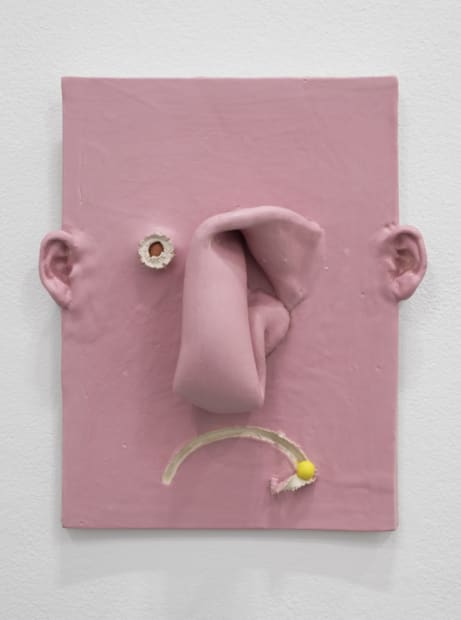-
Rafal Zajko & Jonathan Baldock
In Conversation -
Jonathan Baldock: As someone that knows your practice well, I wanted to ask you about an aspect of it that I think gets overlooked in discussion, in part (and rather selfishly I guess ;-)), because it is an aspect that interests me in relation to my own practise. Both you and I work in performance and both create costumes. I would describe mine as sculptures; new skins inhabited and activated by the performer, they are vessels to enter the worlds I create, acting as kinds of antennae or prosthetics with which to explore them. Quite often they completely disguise the human body. Yours however are much more utilitarian, and in fact you actually wear them yourself on a day to day basis. They make up part of your identity and I’ve been with you many times when people have commented on them and how much they like them etc. Can you talk more about the role of costume in your work.
Is it important that they are unique and individual pieces? Would you ever collaborate with a fashion designer and work on a line? I’m thinking there is a long history of collaborations between the visual arts and fashion.
-

-

-
Rafal : I have used clothing as a creative outlet and form of self-expression, and this seems far more diverse now than it did when I was growing up. My Grandparents who brought me up actually worked in a textile fabric factory all their lives, so I have a connection to fabrics both as a consumer and the producer. For me it is impossible to think about clothes without considering labour. There are no clothes without labour. They are the product of an industry.
Most of my performance works have been set within galleries and against my work, but I’d be really interested in bringing it out into the public sphere to see how people from outside the art community respond and react to it. On a personal level perhaps that’s why I wear my performance uniforms daily as I’m taking it out of gallery context - into the real world.
In regard to uniforms being linked to a lack of individuality - each factory, each industry has their own code of clothing; by working within that construct I’m creating a uniform for a one-person industry - myself. Like you say “individuality” is just market tool for consumerist fashion, so I don’t really see anything unique about the way people dress now; it’s all rather homogenised.
Your costumes often contain masks or headpieces that constrain the view of the performers faces? Being behind the veil is liberating right?
-
 "JUDDER SHUDDER II" WITH FLORENCE PEAKE, KUNSTHALL STAVANGER (2018)
"JUDDER SHUDDER II" WITH FLORENCE PEAKE, KUNSTHALL STAVANGER (2018) -

-
This year I had planned to perform a piece within my show at Kunsthall Stavanger operating the life-sized marionettes within the installation, and in fact, the plan was you and I operating them. It’s unfortunate that we couldn’t, but it’s not stopping us, and I am excited for our performance together within my show at La Casa Encendida in July 2021. I realised it will be our first performance together since we did the live stream performance – “Revolver II” at Matts Gallery in 2014! Audiences have gotten quite used to live streamed performances this year, but at that time it was quite unusual. I don’t think it can ever replace the feeling of really being there and experiencing a performance in person though, but it is perhaps interesting to think how film could be used as tool with this medium.
With this in mind I know at the beginning of the lock down, in March, you had planned to perform at the opening of your solo show at Castor Gallery – Resuscitation. In the end the show had to close on the opening night because of lockdown and never officially opened to the public. You decided to make a film of the performance instead in which you sung and blew vape smoke into the sculpture on display. Has this influenced the film you plan to show at your forthcoming show at PUBLIC opening in March 2021?
-
 SILENT CITADEL - JONATHAN BALDOCK + RAFAL ZAJKO - MATTS GALLERY (2014)
SILENT CITADEL - JONATHAN BALDOCK + RAFAL ZAJKO - MATTS GALLERY (2014) -
Rafal. I’m looking forward to sharing these works also. What I was trying to do with this performance is to question the position of drag not within the gender spectrum, but from the perspective of technology. What if the drag artist instead of performing gender instead took the role of machine or other automation, or, in the case of this particular work - a civil defence siren. They become something otherworldly, a hybrid. Just as the mythical sirens that were a cross between species.
In a mythical sense, sirens were creatures that lived on rocky islands and with their voices lured sailors on their boats to their death on the shores. But, when we think about the use of the siren in our modern understanding it is a device to giving warning of something: war, fire, burglary and prevent harm- so there is a certain dichotomy within the meanings associated with it as it’s now associated with something positive.
So I hope my take on drag expands on the regular take on male/female stereotypes used and tries to give it a fresh , empowering take. In “Song of Sirens” the character bares the message, the message of warning and alertness – a big WAKE UP call.
-






